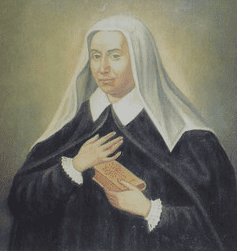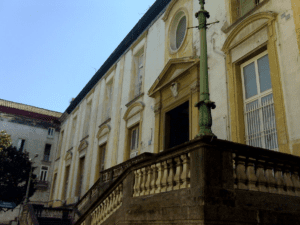Marco Luchetti
Milano, Italy

In the Middle Ages hospitals were charitable institutions that took care of those that could not afford a doctor at home, such as the poor, elderly, orphans, and single mothers. In Naples there was an urgent need for a large facility with many doctors where “incurable” people could be treated for free.
On November 1, 1506, the new sovereign Ferdinando the Catholic of Spain (1452-1515) arrived in Naples, dethroning Federico II of Aragon, thus beginning the vice reign. King Ferdinando brought with him three ministers from the Catalan Council, including Giovanni Lonc.
Giovanni Lonc (Italianized as Longo) was the husband of the Catalan noble Maria Requenses, who was born in Barcelona in 1463. She was affected by a serious form of paralysis (possibly rheumatoid arthritis, or perhaps the result of poisoning), and in 1510 went on pilgrimage to the shrine of Loreto. She was healed while hearing the Gospel story of Jesus healing a paralyzed man with the words: “Tibi dico surge” (Lk 5:24). After this experience she added the name “Lorenza” to her baptismal name and dedicated herself to humanitarian and philanthropic works. She began to visit many charitable circles in Naples: the Hospital of S. Giacomo, the “Fatebenefratelli,” the “Pellegrini,” and the Hospital of S. Nicola al Molo, where she worked tirelessly for seven years.
In June 1495, Naples was a stopover for Charles VIII’s army. Syphilis reached an epidemic level and the kingdom found itself unprepared. Many patients were reduced to the status of “incurables” and were excluded from every existing hospital. Maria Lorenza Longo wanted to organize assistance for these patients, and in 1519 the history of the noblewoman became intertwined with that of Ettore Vernazza, a Genoese notary and founder of the Incurabili Hospital in Genoa and the Hospital of San Giacomo in Augusta in Rome.
On March 11, 1519 Pope Leone X issued the papal bull Nuper pro parte vestra, which established the foundation of the hospital of Santa Maria del Popolo degli Incurabili (Incurables). Between March and September 1519, Maria Longo and Ettore Vernazza worked to find beds, furnishings, and space, beginning on the premises of the old hospital of San Nicola al Molo. At the end of 1519, Ettore Vernazza abruptly left Naples for Rome. It was therefore up to Maria Longo to run the hospital, which she did for the rest of her life. On March 23, 1522 Maria Longo transferred the sick people from the San Nicola al Molo Hospital to the “Incurabili.”
Maria welcomed many pregnant prostitutes to the hospital since they were also marginalized and considered “incurable.” In a very well-known epigraph in Naples she wrote: “Any woman, rich or poor, patrician or plebeian, indigenous or foreign, provided she is pregnant, knock and it will be opened to her.” Many of these women would themselves become instruments of mercy and charity for the poor and the afflicted, forming the “Monastero delle Convertite.” Artists have represented the maternal aspect of this merciful hospitality. In the Historical Pharmacy (the “Spezieria”), which is accessed from the courtyard of the hospital, the reproduction of two large uteri recalls the feminine and maternal origin of those places that have welcomed and continue to welcome suffering people to heal and comfort them.
Religious orders committed to city charity and eminent religious personalities worked in the wards of the hospital over the centuries, many of whom became saints: San Luigi Gonzaga, San Gaetano Thiene, Sant’Alfonso de’ Liguori, Sant’Andrea Avellino, Santa Giovanna Antida Thouret, San Camillo de Lellis, San Francesco Caracciolo, Padre Ludovico da Casoria, and Ven. Bartolo Longo. The most recent of these was San Giuseppe Moscati, who in his work as a lay doctor was able to empty himself of worldly attractions and honors to bend down and embrace Christ in the sick and poor people of the “Incurabili.”

Located within a complex of ancient buildings, which includes three monumental churches, a few dozen meters from the narrow streets of the Neapolitan historical center, the hospital of the “Incurabili” is one of the oldest in the city. The hospital stands on the little hill of Sant’Aniello, which in ancient times was known as a “sacred hill”: legend has it that the mythological Partenope, for whom the city is named, was buried on that land.
The oldest building is accessed through two doors, one to the north and one to the south. On the eastern side there is a staircase that led to the men’s ward on the first floor and the women’s on the second. Opposite the staircase is an elegant double ramp that accessed the baroque pharmacy, an authentic temple of science and art. Next was the entrance to the university clinics and the entrance to the Montalto chapel and the church. On the southern side, a wide staircase signals the entrance to the former Monastero delle Convertite (now a museum of sanitary arts and history of medicine). The Orto Medico and the cloister of Santa Maria delle Grazie, where the prestigious school of obstetrics was located, were annexed later to the original structure.
In 1542 Maria Lorenza Longo passed away. By that time, twenty years after its foundation, the Hospital of S. Maria del Popolo degli Incurabili had become a general hospital thanks to the research activity carried out there. The hospital offered everyone, and free of charge, the most up-to-date care for the diagnosis and treatment of syphilis, cancer, convulsions, paralysis, hydrops, sciatica, asthma, ulcerative gangrene, migraine, delirium, melancholy, ringworm, cholera, and mental illness.
The hospital provided state-of-the-art treatment for people with syphilis: a decoction made from guaiaco and sarsaparilla. The facility included rooms that were hermetically sealed and equipped with stoves and braziers to allow the purging of infected material and induce the sweating needed for therapy. Specific rooms dedicated to the treatment of syphilis were already in full working order in 1568.
At the end of the sixteenth century, the hospital had 1,600 beds and included many collateral services, various pharmacies, a slaughterhouse, the kitchen, a bakery, a wardrobe service, and even interpreters for the many foreigners who needed their services. All patients benefited from continuous thermal conditioning, and nutrition was carefully controlled; the “Spezieria” dispensed drugs to in-patients and even to people who did not want to be hospitalized.
In the eighteenth century, the hospital was enriched by the prestigious Collegio Medico Cerusico. The college, independent of the university but subjected to strict ecclesiastical rules, included among its teachers and pupils the most enlightened physicians of the South, including Cotugno, Sarcone, Amantea, Chiari, Santoro, Boccanera, Scotti, and de Horatiis. Their books and scientific articles, preserved in the ancient libraries and in the hospital archives, are surprisingly accurate in their observations, clinical intuition, audacity of interventions, and attention to results. In this regard, the Neapolitan School equaled the medical culture of the most advanced European states, despite its meager recognition in historical memory. The Collegio Medico Cerusico facilitated the transition of the “Incurabili” to a modern hospital, intended no longer as a place of hospitalization for outcasts but a place capable of modifying the lethal fate of diseases.
During the twentieth century several events impacted the hospital complex: the road layouts, the bombings of the Second World War, and the 1980 earthquake.
Today it seems the end of the story has been written for the “Incurabili.” A few months ago the hospital was evacuated following the collapse of the ceiling of the church of Santa Maria del Popolo, located just below some departments. The hospital, already destined for closure by the regional hospital plan, will likely never be able to reopen.
References
- L’Ospedale di Santa Maria del Popolo, Asl Napoli 1 Centro. URL last accessed July the 20th, 2019.
- Annalisa Micillo, Il Complesso Ospedaliero di Santa Maria del Popolo degli Incurabili di Napoli: evoluzione storico urbanistica, 2013. URL last accessed July the 20th, 2019.
- Volpicella S. L’ospedale di S. Maria del Popolo degl’Incurabili nel secolo 16°. 1856.
- Falanga P. Agostino O. La Venerabile Maria Lorenza Longo, fondatrice dell’Ospedale Incurabili e delle Monache Cappuccine in Napoli, 1463-1542, Laurenziana Editore, Napoli, 1973.
- Fiorillo C. Gli Incurabili. L’Ospedale, la farmacia, il museo. Campanotto Editore, Udine, 1991.
MARCO LUCHETTI, MD, MSc, was born in Napoli, Italy, in 1964. He graduated in Medicine in 1990 and was board certified in Anesthesia and Intensive Care in 1994. He earned a master’s degree in Pain Management in 2010 and was certified as Healthcare Simulation Educator (CHSE) in 2016. He has been working as an Anesthesiologist & Intensivist for more than 20 years. As of 2017, he works as Clinical Manager, Acute Care, Europe, at GE Healthcare. His professional interests include anesthesia, intensive care, emergency medicine, pain management, simulation, and the history of medicine. He has a record of over 50 peer reviewed papers, two books, and several book chapters.

Leave a Reply